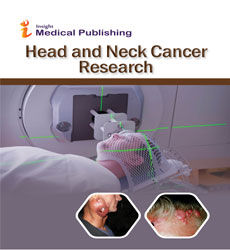An Abnormal Cell Growth in Mouth: A Brief on Oral Cancer
Jiade J. Lu*
DOI10.36648/2572-2107.21.6.34
Jiade J. Lu*
Department of Radiotherapy, Zhejiang Cancer Hospital, China
- *Corresponding Author:
Received date: July 22, 2021; Accepted date: August 05, 2021; Published date: August 12, 2021
Citation: Jiade J. Lu (2021) An Abnormal Cell Growth in Mouth: A Brief on Oral Cancer. Head Neck Cancer Res. Vol.6 No.4.34
Abstract
Cancer is an abnormal cell growth due to uncontrollable mutations at any part of the body. Oral cancer or the mouth cancer is a subgroup of head and neck cancers including oropharynx, larynx, nasal cavity, salivary glands and thyroid gland. Oral cancer occurs at the lining of the lips, mouth, tongue or upper throat. The causative symptoms of the oral cancer, their risk factors, preventive measures, diagnosis, and treatments were mentioned in this article.
Introduction
Cancer is an abnormal cell growth due to uncontrollable mutations at any part of the body. It has the tendency to spread to other organs. Oral cancer or the mouth cancer is a subgroup of head and neck cancers including oropharynx, larynx, nasal cavity, salivary glands and thyroid gland. Oral cancer occurs at the lining of the lips, mouth, tongue or upper throat. Globally, among all the cancers, oral cancer and pharynx cancer ranks in the sixth most occurring or most common cancers. It is mostly endemic in women when compared to men. The latest reports by the Internationals Agency for Research on Cancer (IARC), the oral cancers under oral such as; salivary glands, parotid glands, gingiva, mouth floor, lip are of the highest around the globe.
Symptoms of Oral cancer
The symptoms of cancer in the mouth depend on the location of tumour. In general, they begin as thin white-patches grown irregularly or mixed white and red patches. In mouth cavity, this looks like a persistent ulcer that stay longer than two weeks and does not heal but grows slowly is a warning sign. The ulceration on the lip is commonly crusting and dry, in the pharynx, it is more of a mass and also it can be associated with loose teeth, gum bleeding and persistent ear pain. The other symptoms including difficulty in swallowing associated with pain, swelling in the mouth or sense of numbness in the mouth or lips, lumps and bumps in the neck region.
Risk Factors
As we know, cancers are caused for both the unhealthy habits as well as healthy habits people, based on their factors of cause, the severity varies. So, the risk factors include consumption of alcohol and tobacco which raises the risk of oral cancer by 15 times than in the people who use neither. Few other risk factors include HPV infection, chewing paan, and sun exposure on the lower lip for longer duration.
Tobacco
In comparison between the smokers and non-smokers, smokers are at higher risk. Those who are quitting the tobacco are at lower risks of the cancer attack of about 35% lesser. Even those who are not smoking but are exposed to the environment, they are at higher risk of cancer attack. In general, cigarette smoking weakens the immune system and thereby helps in promoting the cancer causing agents to survive. These agents become a part in alteration by oxidative enzymes, thereby produce the carcinogens. Therefore, the elevated levels of the carcinogens further lead to oral cancer.
Alcohol
Intake of alcohol is risk locally as well as systematically. Because, alcohol due to its nature, it tends to dissolve the lipids, and other mucosal components which let the oral cavity to decrease its salivary flow and further affects the liver ability to look after the carcinogens and implies the increased infections.
Other factors: The cancer that is caused due to the radiations or some virus attacks such as human papillomavirus etc.
Diagnosis
The diagnosis is made by biopsy of the area of concern, extended investigation such as;
• CT scan
• MRI
• PET scan and
• Further clinical examination to determine if the cancer has spread to other parts of the body.
Preventive Measures
The oral cancer risk is reduced by doing the following;
• By avoiding tobacco products
• By quitting paan
• Limiting alcohol consumption
• HPV vaccination and
• Sun protection on the lower lip.
Treatment
The treatment for mouth cancer includes a combination of surgery where the tumour and regional lymph nodes are removed, and radiation therapy, chemotherapy or targeted therapy. The type of treatment depends on the size, location and how extent the cancer has spread along with history and general health of the person. According US study in 2015, the survival rates are more when the disease is diagnosed at early stage compared to if the cancer has spread to the lymph nodes of the neck. The survival rates also depend on the disease location in the oral cavity.
Conclusion
These are the types of oral cancers with symptoms, preventive measures to avoid the risk of cancer, diagnosis and types of treatment for the oral cancers.
Open Access Journals
- Aquaculture & Veterinary Science
- Chemistry & Chemical Sciences
- Clinical Sciences
- Engineering
- General Science
- Genetics & Molecular Biology
- Health Care & Nursing
- Immunology & Microbiology
- Materials Science
- Mathematics & Physics
- Medical Sciences
- Neurology & Psychiatry
- Oncology & Cancer Science
- Pharmaceutical Sciences
